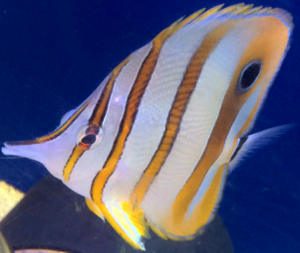
Chelmon rostratus
| Difficulty | High |
| Minimum Tank Size | 120 Gallons |
| Diet | Carnivore |
| Water Parameters | 72-78 F, pH 8-8.4, Salinity 1.020-1.025 |
| Aggression | Peaceful |
| Size | 8" |
Everyone recognizes this fish. Their beautiful golden stripes, long mouth and peculiar personality make it a favorite among aquarists everywhere. They are fairly difficult to care for, and their little mouths can get just about anywhere, resulting in injury when paired with the wrong power head or filter. This combined with their difficult feeding habits and frequency to pick at anemones and inverts makes them difficult to place in the home aquarium.
When selecting your Copperband Butterflyfish always ask to see them fed. They are almost always picky eaters, and seeing them eat readily is a huge pro.
Behavior & Aggression
The Copperband Butterflyfish is one of the most passive fish there is. These guys will not harass any other fish but can easily be harassed by larger fish.
There is however one exception to the Copperband Butterflyfish’s tolerance, other Copperband Butterflyfish. Unless you have a mated pair or an extremely large tank you should not attempt to house multiple butterflyfish. Otherwise they will fight with one another.
Note:When pairing the Copperband Butterflyfish with semi-aggressive fish you will need a tight fitting lid. When startled the Butterfly fish is a frequent jumper, which can lead to a quick loss.
While butterflyfish are generally considered not reef safe, the copperband will generally not bother corals, with a few individuals nipping at them from time to time. The exception here are star polyps, which are frequent targets of the Copperband Butterflyfish. Additionally they will prey upon fan worms and Aiptasia, however you may need to tempt them onto the Aiptasia by covering them with other foods.
Overall the Copperband Butterflyfish is not very hardy making it a poor choice for inexperienced aquarists. Likewise they are not a good starter fish for an uncycled tank and are instead best added to a well established tank.
Diet & Feeding
This is where most aquarists go wrong. It is not uncommon for a butterfly fish to refuse food, even to the point of starvation. For this reason we as responsible aquarists must find foods that they will accept until we can transition them onto our target food.
Remember: The Copperband Butterflyfish is a poor hunter. Feeding the bare minimum in order to reduce waste in the tank will often see these fish slowly starve to death. Opt for more heavy feedings with more frequent water changes.
This video is a perfect for those new to the Copperband Butterflyfish. You can easily see how they will use their long mouths to pull food out of hard to reach areas. Additionally they take very small bites, making group feedings difficult as other fish will frequently out compete them. To keep costs down I distract the other fish and get the Copperband a head start on feeding. This allows me to feed them only frozen mysis which is significantly cheaper than clams. Clams are, however, one of the best foods for getting a picky Copperband Butterflyfish to eat.
As the Copperband Butterflyfish can be picky you may need a variety of frozen foods to get them started. Brine shrimp are the most easily accepted food, however it is also the least nutritious of choices. Only use this if you absolutely cannot get the butterfly to eat anything else.
The second easiest choice would be blood worms. Again these do not have all the nutrients your butterflyfish will need, however they are fairly big and will typically be accepted by picky eaters.
Finally the best frozen food to use is mysis shrimp. These are much more nutritious than the previous two choices, however they are also the least accepted food. You can use all three foods to slowly ween the Copperband Butterflyfish to a healthier diet.
Reviving Emaciated Copperbands
Sometimes when we order fish online we receive a fish far skinnier than we could have imagined. These emaciated fish will often die within a day or two unless extreme action is taken.
The first step is to offer a small amount of food once the fish has settled in. If you have noticed the fish is emaciated before adding them to the main tank I highly suggest you use an isolation tank. This will make the feeding much easier and keep the fish from being harassed.
If the fish is not eating try switching to more easily accepted foods. While they may not be as nutritious any food will help. You can leave a fair amount of food in the tank with them, even if they don’t eat it right away. Part of the reason butterfly fish starve is because they naturally swim around, deciding what to eat. This gives them that opportunity.
Once the fish eats all is not well yet. The key here is to keep the feedings coming. Small but frequent feedings will help them become a healthy weight again.
Breeding & Sexing
Due to their large size and fragile nature, the Copperband Butterflyfish has not been bred in captivity as of yet. Likewise their gender cannot be determined except for size. Males will be larger than females, however the size difference will frequently just be age. For these reasons I cannot recommend trying to pair butterfly fish without a large 200+ gallon tank.